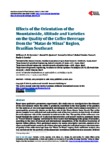Use este identificador para citar ou linkar para este item:
http://www.alice.cnptia.embrapa.br/alice/handle/doc/1055561Registro completo de metadados
| Campo DC | Valor | Idioma |
|---|---|---|
| dc.contributor.author | FERREIRA, W. P. M. | pt_BR |
| dc.contributor.author | QUEIROZ, D. M. | pt_BR |
| dc.contributor.author | SILVAC, S. A. | pt_BR |
| dc.contributor.author | TOMAZ, R. S. | pt_BR |
| dc.contributor.author | CORRÊA, P. C. | pt_BR |
| dc.date.accessioned | 2016-10-28T11:11:11Z | pt_BR |
| dc.date.available | 2016-10-28T11:11:11Z | pt_BR |
| dc.date.created | 2016-10-28 | pt_BR |
| dc.date.issued | 2016 | pt_BR |
| dc.identifier.citation | American Journal of Plant Sciences, n.7, p. 1291-1303, | pt_BR |
| dc.identifier.uri | http://www.alice.cnptia.embrapa.br/alice/handle/doc/1055561 | pt_BR |
| dc.description | Based upon qualitative parameters experiments, this study aims to investigate how the elements of the environment, where the coffee is produced, contribute to the final quality of the product. For the analyses, it was used approximately one kilogram of coffee cherry samples collected in 14municipalities previously chosen on the East side of the Minas Gerais State, Brazil. The coffee cherry samples were collected and analyzed for each of the two varieties in four levels of altitude for each exposure side of the mountain in relation to the Sun. The quality of the coffee was evaluated through the analysis of its physical characteristics and sensory analysis, popularly known as "Test of drink or Cupping" carried out by three tasters that belonging to the group of Q -Graders, according to the rules of national and international competitions of the Brazilian Association of Special Coffees (BSCA). Were performed analysis by means descriptive statistics, analysis of variance and multivariate analysis, all of them aiming to study the individual sensor y characteristics of quality of the coffee beverage from the ?Matas de Minas? region. Path coefficient analysis also was carried out for the partition of the phenotypic correlation coefficients into measures of direct and indirect effects, in order to determine the individual sensory characteristics that playeda major role in the beverage final score. The results demonstrat e that it is not possible to concl usively establish the differences among coffees evaluated with basis on varieties and environmental factors previously cited. It can be concluded that it is not recommended to associate the quality of coffee only to a specific factor whether from the environment or being it a specific of the culture of coffee. However, the cafes that were evaluated had intrinsic quality, which were derived from the specific characteristics of the ?Matas de Minas? region where they were grown. | pt_BR |
| dc.language.iso | eng | eng |
| dc.rights | openAccess | eng |
| dc.subject | Top Quality Coffee | pt_BR |
| dc.subject | Mountain Coffee | pt_BR |
| dc.subject | Coffee Cherry | pt_BR |
| dc.title | Effects of the orientation of the mountainside, altitude and varieties on the quality of the coffee beverage from the "Matas de Minas" region, brazilian Southeast. | pt_BR |
| dc.type | Artigo de periódico | pt_BR |
| dc.date.updated | 2017-03-10T11:11:11Z | pt_BR |
| dc.subject.thesagro | Altitude | pt_BR |
| riaa.ainfo.id | 1055561 | pt_BR |
| riaa.ainfo.lastupdate | 2017-03-10 | pt_BR |
| dc.contributor.institution | WILLIAMS PINTO MARQUES FERREIRA, SAPC; DANIEL M. QUEIROZ, UFV; SAMUEL A. SILVAC, UFES; RAFAEL SIMÕES TOMAZ, FCAT; PAULO C. CORRÊA, UFV. | pt_BR |
| Aparece nas coleções: | Artigo em periódico indexado (SAPC)  | |
Arquivos associados a este item:
| Arquivo | Descrição | Tamanho | Formato | |
|---|---|---|---|---|
| Effectsoftheorientation.pdf | 1,88 MB | Adobe PDF |  Visualizar/Abrir |








